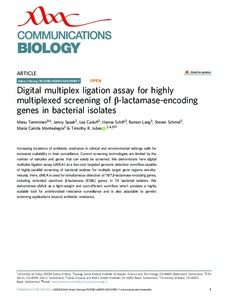Digital multiplex ligation assay for highly multiplexed screening of beta-lactamase-encoding genes in bacterial isolates
Schmid S; Julian TR; Schiff H; Spaak J; Tamminen M; Lang R; Montealegre MC; Caduff L
Digital multiplex ligation assay for highly multiplexed screening of beta-lactamase-encoding genes in bacterial isolates
Schmid S
Julian TR
Schiff H
Spaak J
Tamminen M
Lang R
Montealegre MC
Caduff L
NATURE PUBLISHING GROUP
Julkaisun pysyvä osoite on:
https://urn.fi/URN:NBN:fi-fe2021042823182
https://urn.fi/URN:NBN:fi-fe2021042823182
Tiivistelmä
Increasing incidence of antibiotic resistance in clinical and environmental settings calls for increased scalability in their surveillance. Current screening technologies are limited by the number of samples and genes that can easily be screened. We demonstrate here digital multiplex ligation assay (dMLA) as a low-cost targeted genomic detection workflow capable of highly-parallel screening of bacterial isolates for multiple target gene regions simultaneously. Here, dMLA is used for simultaneous detection of 1187 beta-lactamase-encoding genes, including extended spectrum beta-lactamase (ESBL) genes, in 74 bacterial isolates. We demonstrate dMLA as a light-weight and cost-efficient workflow which provides a highly scalable tool for antimicrobial resistance surveillance and is also adaptable to genetic screening applications beyond antibiotic resistance.Tamminen et al. develop a digital multiplex ligation assay (dMLA) that enables the detection of bacterial isolates using probe hybridization and ligation-based assays with next-generation sequencing. Their method can be applied in high-throughput and affordable screening for antibiotic resistance.
Kokoelmat
- Rinnakkaistallenteet [19207]
